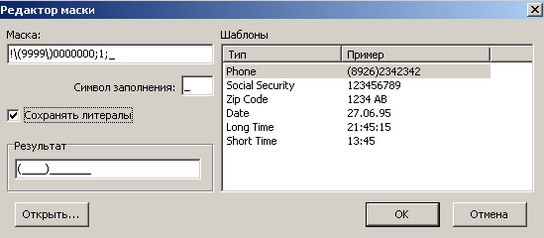String with mask |




|
|
Properties of a component: Ctl3D, Height, Enabled, Dataset name, Name, Edit mask, Top, Left, Tab order, Color, Width, Font. Edit mask - property allows to set a mask. It is a sequence of the special codes, defining for a line of editing a format of a text containing in the line. For making up a mask it is possible to use theletter.
The mask consists of three fields divided by a symbol ";". The first field is actually a mask. The second field is the symbol defining whether literal symbols are considered as a part of data. The symbol "1" is used by default, and literal symbols of a mask are a part of the text entered by the editor. If to set a symbol "0" instead of "1" literal symbols of a mask will be displayed still in a field of the editor at entering of the text into it. The third field contains a symbol used for representation of a space character in a mask, by default it is a symbol of underlining. If neither the second, nor the third fields are defined, for them values by default are used. In a mask it is possible to apply the following special symbols: ! - the initial space characters are suppressed in the text. If a symbol ! is absent then the final space characters are suppressed. > - symbols which follow this symbol are translated into the upper register up to occurrence of a symbol <. <-symbols which follow this symbol are translated into the lower register up to occurrence of a symbol >. <> - check of symbols registers is not made. \ - the symbol following this symbol is a literal symbol. L - the alphabetic symbol should be entered into positions. l (lower case of latin letter L) - an alphabetic symbol can be entered in positions. A - the alphanumeric symbol should be entered into positions. a - the alphanumeric symbol can be entered into positions. C - the symbol should be entered into positions. c - the symbol can be entered into positions. 0 - the digital symbol should be entered into positions. 9 - the digital symbol can be entered into positions. # - the digital symbol can be entered into positions or + and -. : - it is used for division of hours, minutes and seconds in indications of time. / - it is used for division of days, months and years in dates. ; - symbol divides fields of a mask. _ - symbol reserves the empty space in a window of editing, being as automatically missed divider and into which it is impossible to enter the information. Examples of masks: ! 99/99/00; 1; _ - to enter the date. ! 90:00; 1; _ - to indicate time. l_l_l_l_l_l _; l; _ - to enter a word by length no more than six letters (between letters the spaces are displayed). To prepare a mask it is possible and manually, however it is more difficult. If necessary, it is conveniently to use the Mask editor to choose a suitable mask from a file of masks (*.dem), and then to modify it. The example of a file of masks is applied together with installation of system in a directory ' \Panorama9 \DATA \PODOLSK \DataBase \rus.dem '. Tab order - sets a serial number of a component at detour of a component by "Tab" key. |

